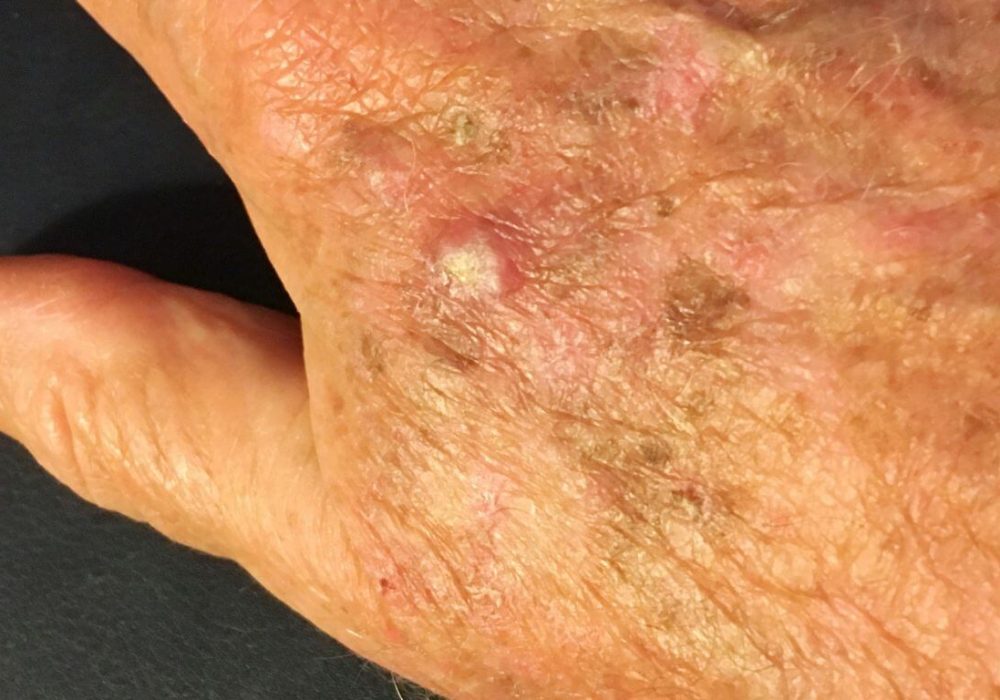
Squamous cell carcinoma of the skin
Squamous cell carcinoma of the skin is a type of cancer that starts as a growth of cells on the skin. It starts in cells called squamous cells. The squamous cells make up the middle and outer layers of the skin. Squamous cell carcinoma is a common type of skin cancer.
Squamous cell carcinoma of the skin is usually not life-threatening. But if it’s not treated, squamous cell carcinoma of the skin can grow large or spread to other parts of the body. The growth of the cancer can cause serious complications.
Most squamous cell carcinomas of the skin are caused by too much ultraviolet (UV) radiation. UV radiation comes either from sunlight or from tanning beds or lamps. Protecting your skin from UV light can help reduce the risk of squamous cell carcinoma of the skin and other forms of skin cancer.
Squamous cell carcinomas can be anywhere on the skin. In people who sunburn easily, the cancer is usually found on areas of skin that have had a lot of sun. In people with Black and brown skin, squamous cell carcinomas are more likely to be on skin that isn’t exposed to sun, such as the genitals.
Symptoms
Squamous cell carcinoma of the skin most often occurs on sun-exposed skin. This includes the scalp, the backs of the hands, the ears or the lips. But it can occur anywhere on the body. It can even occur inside the mouth, on the bottoms of the feet or on the genitals. When squamous cell carcinoma of the skin happens in people with Black and brown skin, it tends to happen in places that aren’t exposed to the sun.
Symptoms of squamous cell carcinoma of the skin include:
- A firm bump on the skin, called a nodule. The nodule might be the same color as the skin, or it might look different. It can look pink, red, black or brown, depending on skin color.
- A flat sore with a scaly crust.
- A rough, scaly patch on the lip that may become an open sore.
- A sore or rough patch inside the mouth.
- A raised patch or wartlike sore on or in the anus or on the genitals.
Causes
Squamous cell carcinoma of the skin occurs when the squamous cells in the skin get changes in their DNA. Cells’ DNA holds the instructions that tell cells what to do. The changes tell the squamous cells to multiply quickly. The cells continue living when healthy cells would die as part of their natural life cycle.
HAND PROBLEMS
- Fractures and Dislocations in Hand
- Metacarpal & Phalangeal fractures
- Ligamentous injuries of fingers & Thumb
- Dislocations of finger joints
- Swellings of Fingers & Hand
- Compartment Syndrome
- Mucous cyst
- Ganglion cyst / Retinacular Cyst
- GCT of Tendon sheath
- Enchondroma (Benign Bone Tumor)
- Squamous cell carcinoma
- Dupuytrens Contracture
- Post Traumatic Contracture
- Post Burn Contractures of fingers
- Volkmann Ischemic Contracture
- Stiff Fingers & CRPS
- Stiff joints of fingers and hand
- Osteoarthritis of Hand
- Finger joint arthritis
- Thumb Basal joint arthritis
- Acute Infections of Hand
- Finger Pulp Infection (Felon)
- Nail Fold Infection (Paronychia)
- Finger Infection (Flexor Tenosynovitis)
- Palm Infection (Deep Spaces of Hand infection)
- Joint Infections in Hand & Wrist (Septic Arthritis)
- Human & Animal bite injuries to hand
- Diabetic Hand Infections
- Bacterial / Fungal / Atypical Hand infections in immunocompromised patients
- Subungual Hematoma
- Nail bed injury
- Nail Deformities
- Glomus tumor
Make Your Appointment
This causes too many cells. The cells can invade and destroy healthy body tissue. In time, the cells can break away and spread to other parts of the body.
Ultraviolet (UV) radiation causes most of the DNA changes in skin cells. UV radiation can come from sunlight, tanning lamps and tanning beds.
But skin cancers also can grow on skin that’s not usually in sunlight. This means that other factors might add to the risk of skin cancer. One such factor might be having a condition that weakens the immune system.
Risk factors
Factors that can increase the risk of squamous cell carcinoma of the skin include:
- Having skin that sunburns easily. Anyone of any skin color can get squamous cell carcinoma of the skin. But it's more common in people who have low levels of melanin in their skin. Melanin is a substance that gives color to skin. It also helps protect the skin from damaging ultraviolet (UV) radiation. People with Black or brown skin have more melanin than people with white skin.
- Being in the sun too much. UV radiation from the sun increases the risk of squamous cell carcinoma of the skin. Covering the skin with clothes or sunblock can help lower the risk.
- Using tanning beds. People who use indoor tanning beds have an increased risk of squamous cell carcinoma of the skin.
- Having a history of sunburns. Having had one or more sunburns that raised blisters as a child or teenager increases the risk of developing squamous cell carcinoma of the skin as an adult. Sunburns in adulthood also are a risk factor.
- Having a history of precancerous skin lesions. Some types of skin sores can turn into skin cancer. Examples are actinic keratosis or Bowen disease. Having one of these conditions increases the risk of squamous cell carcinoma.
- Having a history of skin cancer. People who've had squamous cell carcinoma of the skin once are much more likely to get it again.
- Having a weakened immune system. People with weakened immune systems have an increased risk of skin cancer. This includes people who have leukemia or lymphoma. And it includes those who take medicines to control the immune system, such as those who have had organ transplants.
- Having a rare genetic disorder. People with xeroderma pigmentosum, which causes great sensitivity to sunlight, have a greatly increased risk of developing skin cancer.
Complications
Untreated squamous cell carcinoma of the skin can destroy nearby healthy tissue. It can spread to the lymph nodes or other organs. And it can be fatal, although this is not common.
The risk of squamous cell carcinoma of the skin spreading may be higher if the cancer:
- Grows very large or deep.
- Involves the mucous membranes, such as the lips.
- Occurs in a person with a weakened immune system. Examples of things that might cause a weakened immune system include having chronic leukemia or taking medicine to control the immune system after an organ transplant.
Prevention
Most squamous cell carcinomas of the skin can be prevented. To protect yourself:
- Stay out of the sun during the middle of the day. For much of North America, the sun’s rays are strongest between about 10 a.m. and 3 p.m. Plan outdoor activities at other times of the day, even during winter or when the sky is cloudy. When outside, stay in shade as much as possible.
- Wear sunscreen year-round. Use a broad-spectrum sunscreen with an SPF of at least 30, even on cloudy days. Apply sunscreen generously. Apply again every two hours, or more often if you’re swimming or sweating.
- Wear protective clothing. Wear dark, tightly woven clothes that cover arms and legs. Wear a wide-brimmed hat that shades your face and ears. Don’t forget sunglasses. Look for those that block both types of UV radiation, UVA and UVB rays.
- Don’t use tanning beds. The lights in tanning beds give off UV radiation. Using tanning beds increases the risk of skin cancer.
Check your skin often and report changes to your health care team. Look at your skin often for new growths. Look for changes in moles, freckles, bumps and birthmarks. Use mirrors to check your face, neck, ears and scalp.
Look at your chest and trunk and the tops and undersides of your arms and hands. Look at the front and back of your legs and your feet. Look at the bottom of the feet and the spaces between your toes. Also check your genital area and between your buttocks.
